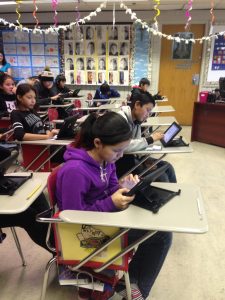How Do First Nation Schools Receive Funding?
By Ed Mirasty
PAGC Director of Education
At the Assembly of First Nations Education Directors’ Forum held on March 1-2, 2017 in Calgary, it was expressed by the participants that communities don’t fully understand the way schools receive their funding. This was problematic since many of our First Nations have begun dialogue on Transformation Education initiatives and wanted to know more about the funding of schools. Therefore, the following will explain the three ways First Nations schools typically receive their funding that include Nominal Roll, Special Education, and Proposal-Driven Funding.
Nominal Roll
This method of accessing funds is the most important source of school revenue since the nominal roll makes 85% of the overall education funding. When students come into school, attendance is recorded on the teachers’ registers and that number is calculated on a per student or full-time equivalent (FTE) basis. Indigenous and Northern Affairs Canada (INAC) count the nominal roll every fall to determine how many students attend in September and October. Kindergarten students are calculated in a 0.5 FTE (Kindergarten is half-time) and Grades 1-12 students = 1 FTE. Consequently, if 300 FTEs are the total registered students attending, then INAC’s funding formula is applied and designate $10,000 per FTE x 300 students = $3,000,000 for that school’s budget. The nominal roll funding is used to pay for teachers, administration, transportation and operation and maintenance.
It is crucial for teachers and parents to follow-up on students who miss school because INAC may cut them from the nominal roll if attendance is an issue. That shortfall can make the difference between hiring extra teachers, opening a carpentry class and/or running extra-curricular programs. If parents and guardians called the school to let teachers know their child is sick or at the trap-line, then it can be recorded as an excused absenteeism. Consequently, if students miss more than 50% of the months of September and October, then students are removed from the nominal roll-even if they return after Christmas.
For most schools within the Prince Albert Grand Council, 2.5% of their nominal roll pays for second-level services. This service provided by the PAGC office provides teacher services, teacher/principal evaluations, curriculum support and facilitate Information Technology services to the schools. With the exception of Lac La Ronge Indian Band, all other PAGC communities contribute the 2.5% tuition for these essential services.
Special Education
The Prince Albert Grand Council has established the Regional Management Organization (RMO) which manages the funding allocations for Special Education services. In order to receive funding for students with special needs (i.e. – cognitive/behavior), schools need to qualify their students through assessments from licensed educational psychologists and other certified professionals. Students may qualify for either Level 1($20,500) or Level 2 ($31,000) funding for each designated student. Cognitive and behavioral assessments must be completed once every three years to maintain funding at the school. Those school-directed resources pay for special education teachers, teacher assistants, special education equipment and services.
To assist with service delivery, RMO staff do provide a broad range of special education services to our schools through the tribal council’s Regional Management Organization (RMO) program. Indirect Services resources also is allocated to PAGC to employ nine staff members who go into the communities to help with Special Education services, certification, evaluation and present programs to schools.
Proposal-Driven Funding
The PAGC Directors/Coordinators submit annual INAC proposals that are called First Nations School Success Plan (FNSSP) and New Paths. Since the new funding investments have gone up, the vast majority of the proposal-driven funding go to schools for literacy, numeracy and student retention initiatives. The PAGC education office utilize proposal-driven funding for professional development, resource materials and curriculum support to all of the schools.
Both proposal-driven funding programs allow teachers, administrators and students to obtain more support at the local level. Every March, the Directors/Coordinators meet to revise and /or modify the FNSSP and New Paths proposals based on the test results administered at the school-level. The data collected provides insight into weaknesses of students and adjustments are made as a team to ensure the schools’ needs are met.
Conclusion
All three levels of funding allow for schools to work together to ensure students will graduate with the skills, language and cultural understanding to succeed in education. The PAGC and its member First Nations have been working as a team since the department was formed in the mid-1970s. The Directors/Coordinators have been instrumental in developing a strategic approach to school success and to ensure the Treaty Right to Education is protected and maintained. At the end of the day, PAGC Education does not keep any funding, but ensures the resources return to communities through materials, school support and teacher training, etc.
